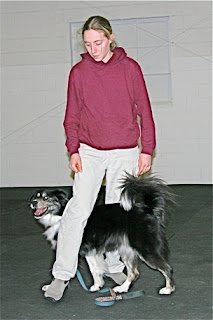One of the things that many dog teams will say, especially those working on competition training or behavior modification, is “I just think he would do so much better if you were training him.”
And the thing is, most dogs would do better with a trainer handling them. It’s not that there’s anything magical about most dog trainers (though there are a few I wonder about….). Most of these people have spent a lot of time training dogs, which means more practice, better decision making, better timing, better able to adjust criteria, and being able to evaluate the situation**.
That said, it’s important to recognize that most trainers probably think the same thing at various points.
What would Blaze and Luna be like if they were in a home where they got appropriate help as puppies? Several trainers I admire talk about their challenging dogs and being able to overcome the challenges. I’ve had to accept that it just won’t happen with Blaze. With Luna, who knows what progress is available, we’re battling the lack of early socialization and bad luck with genetics. And while Griffin is a very normal and adorable dog…. he has siblings competing at the highest levels and yet we’ve had to twice walk out of the rally ring after less than half the course. It’s definitely all me holding him back.
I know Griffin would do better with many of my students. He would benefit from long walks in town every day, from a busier household, with more time and attention and regular attendance in class. Hours and hours in the woods. A classroom full of kids every day. He would do well with someone who is a perfectionist. And I can’t give him all of those things right now.
So what do I do?
– I make training plans for my dogs to address the biggest issue areas. I try to be productive with our time. We try to maximize the benefits of any choices we make on how to spend our time.
– I try to improve my skills. I spend time training my dogs and any others (….one of the reasons I volunteer at the shelter!). With good practice, I should get better.
– My class/lesson students are also part of this. This allows me to see things that work and don’t work as well with hundreds and hundreds of dogs. There’s no way I could learn so much with just working with my own dogs.
– I learn more and try new things. Seminars, books, DVDs, online articles and resources. Training groups and classes. There is just so much information available now.
– Learn from the best: In whatever area we’re looking at. We use whatever materials we can get ahold of. We use what we can, make modifications of others, and try to evaluate and work to maximize our success.
And how is that working? I’m continually making refinements to our training plans. I’m getting better. The learning curve is not as steep as it was a few years ago. But if a small change cuts off minutes or hours of training, all the better.
 |
| Photo by Terri Tepper, 2008 |
**Massive amounts of practice or dedication are not, alone, sufficient. The practice time has to be “good practice.” Spending many training hours of late clicking will only let someone get more proficient at late clicking. Some people are able to self-evaluate. Others need class and learning opportunities to become more proficient.